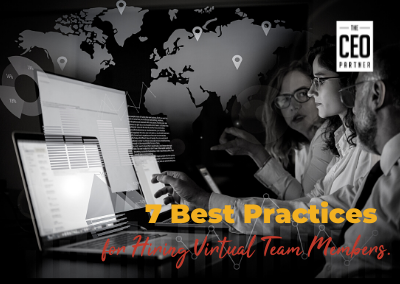As the world gets more digitally connected with each passing day, the modern workplace is constantly evolving. One of the ways in which this is apparent is in the rise of virtual teams across businesses. Telecommuting is becoming more common as many jobs can be effectively carried out from remotely when employees are armed with a laptop, internet, and other mobile devices. One HBR article elucidates that when a survey was carried out for 1700 knowledge workers, 79% reported to be working fully or partially remotely. So with more remote work, the process of hiring virtual team members becomes important.
If your business is beginning to see real growth then you need to think about scaling up effectively. One of the pertinent ways to scale up is by hiring more virtual team members. Considering that remote working is gaining so much momentum nowadays, you can look at hiring virtual team members to take your business one step ahead. However, when hiring remote workers, you will need to follow certain practices while avoiding others to make the right decisions.
Keeping that in mind, we bring to you 7 best practices to follow when hiring virtual team members. Additionally, we have also listed down what mistakes you should avoid, making this process effective. Read on to know more about the process of hiring virtual team members!
1. Create A Structure to Hire Virtual Team Members
Before looking to hire virtual employees, you will need to evaluate the existing team structures. Bringing in someone who will be working primarily through telecommuting, necessitates that their role and responsibilities are clearly laid down beforehand. This not only reduces confusion once the person starts working but also makes it easier for you to search for the perfect candidate.
Some points that you need to consider at this stage of hiring virtual team members are-
- Which areas or roles need expansion?
- What will be the job responsibilities of the incumbent?
- Will it be an individual contributor role or a team one?
- How will the role fit within the existing team structure?
2. Formulate An Application Screening Process
Having a tailored application screening mechanism in place is an integral step to creating a robust process for hiring virtual team members.
Narrowing down the job responsibilities gives you a good idea of what to look for in a potential candidate. Another important way to ensure that a proper application pool is created is to know where to look for people. For highly specialized jobs, you can check for particular job portals in the field. Having a reference program also helps to bring in suitable candidates.
An effective application screening process can save you both time and money while bringing you the right candidates for your team.
3. Have Face-To-Face Interactions
Telephone interviews are a thing of the past. Remote hiring must be conducted through video conferencing. This gives both parties a chance for face-to-face interaction, albeit digitally. Software applications like Zoom, Skype, and Microsoft Teams are handy tools when it comes to conducting video interviews.
Interviewers should take the opportunity to ask relevant questions in these video calls to learn more about the candidates. One important thing to remember is that when it comes to questions, interviewers must not treat a remote hiring process any different from the traditional in-person interview. The essence of the matter remains the same, only the implementation is different.
4. Conduct A Behavioral Interview
Certain behavioral capabilities are essential for employees who work virtually. Not everyone who looks good on paper is fit for remote work. That is why specific behavioral interview questions need to be asked to understand the intrinsic values and qualities of the candidates. A few pertinent and useful qualities to look for while conducting such an interview are as follows-
- Whether the person is self-motivated to do the job.
- Whether they are a self-starter and can work with minimum supervision
- Whether they are capable of juggling deadlines and able to prioritize effectively.
- Whether they are disciplined and organized in their approach.
5. Test The Candidate’s Skills
Behavioral and skills testing is an excellent way to learn about and assess candidates. Various assessments for knowledge, personality, cognitive abilities, and skill levels can be tailored for specific roles. These tests allow recruiters to cull out the candidates who do not fit the requirements and proceed with the ones who are suitable.
When hiring for remote workers, these skill testings become all the more important as they can give you a clear picture of the person’s suitability for the role.
6. Have Your Paperwork Ready
Maintaining legal compliance is an important aspect of the hiring procedure. However, in a remote setting, it can be a little tricky, especially when it comes to signing joining documents. But this can be handled easily with strategic planning.
To prevent your new hires from feeling pressured to visit a physical office location, you can create soft versions of the necessary joining documents. These documents can be electronically signed by the employees and sent to you for record-keeping.
Background checks are an integral part of the hiring process globally. Proper checking is essential even if you hire remotely.
Implement a process to carry out the necessary criminal and other relevant reference checks so that you can extend an offer to a candidate.
7. Arrange Team Introductions After Hiring Virtual Team Members
Introduce your new employees to the organization through personalized emails when they join. Additionally, you can also arrange for a welcome video call with the team as an initial ice-breaker.
Another important initial interaction that a new employee should have once they join is a one-on-one video call with their immediate manager. This meeting is crucial to set the initial expectations and to answer any questions the new hire might have regarding their work.
Some Mistakes To Avoid When Hiring Virtual Team Members
The process for hiring virtual team members need to be more specific than regular in-person recruitment processes. This is because the absence of a physical face-face to interaction necessitates that the entire process is very targeted towards understanding the skills of the candidate and to determine if they are a good fit. In light of that, here are some mistakes that you must avoid making while undertaking this procedure-
- Do not hurry through the process at the cost of being thorough. Hiring is a costly process- both in terms of money and time. As a result, hiring the wrong candidate can cost your business in the long run.
- Do not forget to emphasize soft skills like communication capabilities, collaborative mentalities, empathy, and team working capabilities. These are extremely important to build an effective virtual team.
- Do not forget to create an environment of open communication both during the hiring process and after. Since virtual teams do not meet in person, communication channels must be open and honest to maintain effectivity.
- Do not underestimate the need for a robust candidate support mechanism. Interviewees as well as new joiners will have a lot of questions that must be answered. Having a support system will create an overall great experience for these people.
In Conclusion
Remote working is expected to become a more prevalent practice in the days to come. Taking time to prepare for the process and implementing well-thought-out strategies for hiring virtual team members are some of the ways in which your business can stay ahead of competitors. Creating virtual teams that work productively and in tandem is the key to your business achieving a sustainable advantage over others in the field. Contact us today for more information on how to make your virtual work more efficient and successful.

